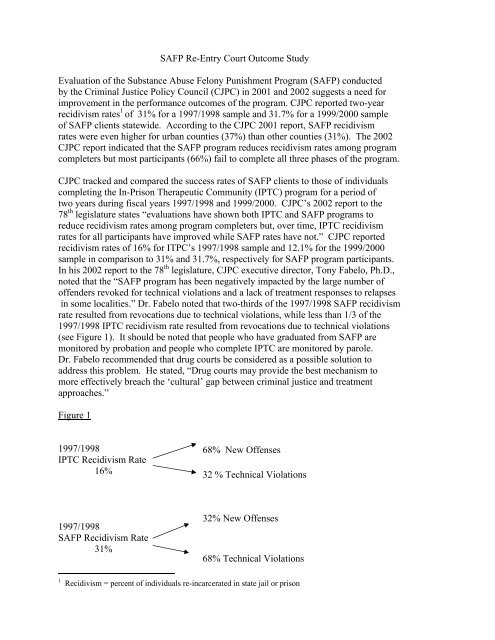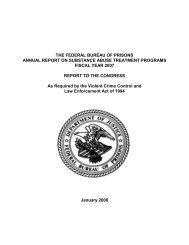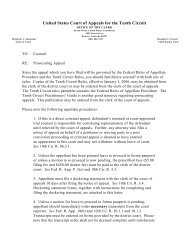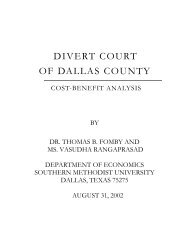SAFP Re-Entry Court Outcome Study Evaluation of the Substance ...
SAFP Re-Entry Court Outcome Study Evaluation of the Substance ...
SAFP Re-Entry Court Outcome Study Evaluation of the Substance ...
Create successful ePaper yourself
Turn your PDF publications into a flip-book with our unique Google optimized e-Paper software.
<strong>SAFP</strong> <strong>Re</strong>-<strong>Entry</strong> <strong>Court</strong> <strong>Outcome</strong> <strong>Study</strong><br />
<strong>Evaluation</strong> <strong>of</strong> <strong>the</strong> <strong>Substance</strong> Abuse Felony Punishment Program (<strong>SAFP</strong>) conducted<br />
by <strong>the</strong> Criminal Justice Policy Council (CJPC) in 2001 and 2002 suggests a need for<br />
improvement in <strong>the</strong> performance outcomes <strong>of</strong> <strong>the</strong> program. CJPC reported two-year<br />
recidivism rates 1 <strong>of</strong> 31% for a 1997/1998 sample and 31.7% for a 1999/2000 sample<br />
<strong>of</strong> <strong>SAFP</strong> clients statewide. According to <strong>the</strong> CJPC 2001 report, <strong>SAFP</strong> recidivism<br />
rates were even higher for urban counties (37%) than o<strong>the</strong>r counties (31%). The 2002<br />
CJPC report indicated that <strong>the</strong> <strong>SAFP</strong> program reduces recidivism rates among program<br />
completers but most participants (66%) fail to complete all three phases <strong>of</strong> <strong>the</strong> program.<br />
CJPC tracked and compared <strong>the</strong> success rates <strong>of</strong> <strong>SAFP</strong> clients to those <strong>of</strong> individuals<br />
completing <strong>the</strong> In-Prison Therapeutic Community (IPTC) program for a period <strong>of</strong><br />
two years during fiscal years 1997/1998 and 1999/2000. CJPC’s 2002 report to <strong>the</strong><br />
78 th legislature states “evaluations have shown both IPTC and <strong>SAFP</strong> programs to<br />
reduce recidivism rates among program completers but, over time, IPTC recidivism<br />
rates for all participants have improved while <strong>SAFP</strong> rates have not.” CJPC reported<br />
recidivism rates <strong>of</strong> 16% for ITPC’s 1997/1998 sample and 12.1% for <strong>the</strong> 1999/2000<br />
sample in comparison to 31% and 31.7%, respectively for <strong>SAFP</strong> program participants.<br />
In his 2002 report to <strong>the</strong> 78 th legislature, CJPC executive director, Tony Fabelo, Ph.D.,<br />
noted that <strong>the</strong> “<strong>SAFP</strong> program has been negatively impacted by <strong>the</strong> large number <strong>of</strong><br />
<strong>of</strong>fenders revoked for technical violations and a lack <strong>of</strong> treatment responses to relapses<br />
in some localities.” Dr. Fabelo noted that two-thirds <strong>of</strong> <strong>the</strong> 1997/1998 <strong>SAFP</strong> recidivism<br />
rate resulted from revocations due to technical violations, while less than 1/3 <strong>of</strong> <strong>the</strong><br />
1997/1998 IPTC recidivism rate resulted from revocations due to technical violations<br />
(see Figure 1). It should be noted that people who have graduated from <strong>SAFP</strong> are<br />
monitored by probation and people who complete IPTC are monitored by parole.<br />
Dr. Fabelo recommended that drug courts be considered as a possible solution to<br />
address this problem. He stated, “Drug courts may provide <strong>the</strong> best mechanism to<br />
more effectively breach <strong>the</strong> ‘cultural’ gap between criminal justice and treatment<br />
approaches.”<br />
Figure 1<br />
1997/1998<br />
IPTC <strong>Re</strong>cidivism Rate<br />
16%<br />
68% New Offenses<br />
32 % Technical Violations<br />
1997/1998<br />
<strong>SAFP</strong> <strong>Re</strong>cidivism Rate<br />
31%<br />
32% New Offenses<br />
68% Technical Violations<br />
1 <strong>Re</strong>cidivism = percent <strong>of</strong> individuals re-incarcerated in state jail or prison
In 2001, District <strong>Court</strong> Judge Robert Francis created a re-entry court, using <strong>the</strong> drug court<br />
model, to improve performance outcomes <strong>of</strong> <strong>SAFP</strong> program participants in Dallas County.<br />
Early evaluation <strong>of</strong> Judge Francis’ re-entry court supports Dr. Fabelo’s assertion that<br />
drug courts may improve <strong>SAFP</strong> program outcomes. The evaluation compared <strong>the</strong> recidivism<br />
rates 2 <strong>of</strong> 50 re-entry court participants randomly selected from a pool <strong>of</strong> <strong>SAFP</strong> returnees to a<br />
comparable sample <strong>of</strong> 50 <strong>SAFP</strong> program participants (comparison group) selected from<br />
<strong>the</strong> same pool <strong>of</strong> <strong>SAFP</strong> returnees. Comparison participants were evenly distributed among<br />
13 <strong>of</strong> <strong>the</strong> remaining district courts in Dallas County.<br />
Within <strong>the</strong> first year following re-entry into <strong>the</strong> community, 3 4% or 2 re-entry court<br />
participants recidivated compared to 24% or 12 comparison group participants (see Figure 2).<br />
These results show <strong>the</strong> addition <strong>of</strong> re-entry court to <strong>the</strong> <strong>SAFP</strong> program resulted in an 83%<br />
reduction in recidivism for Dallas County <strong>SAFP</strong> program participants. Three-fourths <strong>of</strong><br />
<strong>the</strong> comparison group recidivism rates are due to revocations for technical violations while<br />
½ <strong>of</strong> <strong>the</strong> re-entry court recidivism rates resulted from revocations for technical violations.<br />
In o<strong>the</strong>r words, nine <strong>of</strong> <strong>the</strong> 12 comparison group participants who recidivated were revoked<br />
for technical violations while one <strong>of</strong> <strong>the</strong> two re-entry court participants who recidivated were<br />
revoked for technical violations (see Figure 3).<br />
Figure 2<br />
30<br />
<strong>Re</strong>cidivism Rates by Group 1-Year after <strong>Re</strong>-entry<br />
into <strong>the</strong> Community<br />
25<br />
24<br />
20<br />
Percent <strong>Re</strong>cidivating<br />
15<br />
10<br />
5<br />
0<br />
Comparison<br />
4<br />
<strong>Re</strong>-<strong>Entry</strong> <strong>Court</strong><br />
GROUP<br />
<strong>Re</strong>cidivism = Percent <strong>of</strong> Participants <strong>Re</strong>-incarcerated in State Jail or<br />
Prison Within 1-Year after <strong>Re</strong>-entry into <strong>the</strong> Community<br />
2 <strong>Re</strong>cidivism rates include <strong>the</strong> percent <strong>of</strong> individuals re-incarcerated in prison or state jail<br />
within one year <strong>of</strong> re-entry into <strong>the</strong> community.<br />
3 <strong>Re</strong>-entry into <strong>the</strong> community begins when participants are released from <strong>the</strong> institutional<br />
portion <strong>of</strong> <strong>the</strong> <strong>SAFP</strong> program.
Figure 3<br />
Comparison Group<br />
<strong>Re</strong>cidivism Rate<br />
24%<br />
25% New Offenses (3 Participants)<br />
75% Technical Violations<br />
75% Technical Violations (9 Participants)<br />
<strong>Re</strong>-entry <strong>Court</strong><br />
<strong>Re</strong>cidivism Rate<br />
4%<br />
50% New Offenses (1 Participant)<br />
50% Technical Violations (1 Participant)<br />
While CJPC reports on <strong>SAFP</strong> have defined recidivism as <strong>the</strong> percent <strong>of</strong> clients<br />
re-incarcerated in state jail or prison, district court judges statewide tend to define<br />
recidivism as <strong>the</strong> percent <strong>of</strong> <strong>of</strong>fenders re-arrested for new <strong>of</strong>fenses. Consequently,<br />
<strong>the</strong> re-entry court evaluation also tracked and compared <strong>the</strong> re-arrests rates <strong>of</strong><br />
re-entry court participants to those <strong>of</strong> comparison group participants for 1 year<br />
following re-entry into <strong>the</strong> community. Twenty percent <strong>of</strong> comparison participants<br />
relative to 10% <strong>of</strong> re-entry court participants committed new <strong>of</strong>fenses within one<br />
year after re-entry into <strong>the</strong> community, resulting in a 50% reduction in re-arrests<br />
for new <strong>of</strong>fenses (see Figure 4).<br />
Figure 4<br />
Percent Arrested for New Offense by Group<br />
1-Year after <strong>Re</strong>-entry into <strong>the</strong> Community<br />
22<br />
20<br />
18<br />
20<br />
16<br />
Percent Committing New Offense<br />
14<br />
12<br />
10<br />
8<br />
6<br />
4<br />
2<br />
0<br />
Comparison<br />
10<br />
<strong>Re</strong>-entry <strong>Court</strong><br />
GROUP
Figures 5 and 6 show <strong>the</strong> status <strong>of</strong> both groups within one year after re-entry into <strong>the</strong><br />
community. It is noteworthy that approximately 70% <strong>of</strong> re-entry court participants relative<br />
to 33% <strong>of</strong> comparison group participants had completed or were still on probation within<br />
one year after re-entry into <strong>the</strong> community. Fifty percent <strong>of</strong> comparison participants had<br />
absconded (25%) or were revoked (25%) while only eleven percent <strong>of</strong> re-entry court<br />
participants had absconded (7%) or were revoked (4%) within one year after re-entering<br />
<strong>the</strong> community.<br />
Figure 5<br />
Status <strong>of</strong> Comparison Group Within<br />
1-Year after <strong>Re</strong>-entry into Community<br />
Probaiton Completed<br />
6.1%<br />
<strong>Re</strong>voked<br />
24.5%<br />
Absconded<br />
24.5%<br />
In Jail<br />
16.3%<br />
On Probation<br />
Safpf <strong>Re</strong>lapse<br />
26.5% 2.0%<br />
Figure 6<br />
Status <strong>of</strong> <strong>Re</strong>-entry <strong>Court</strong> Group Within<br />
1-Year after <strong>Re</strong>-entry into Community<br />
Shocked<br />
2.1%<br />
Salvation Army<br />
2.1%<br />
<strong>Re</strong>voked<br />
2.1%<br />
Absconded<br />
6.4%<br />
In Jail<br />
12.8%<br />
Safpf <strong>Re</strong>lapse<br />
4.3%<br />
On Probation<br />
70.2%
Overall, <strong>the</strong> initial evaluation <strong>of</strong> re-entry court shows promising outcomes for <strong>SAFP</strong><br />
program clients who participated in <strong>the</strong> court. <strong>Re</strong>sults show a significant decrease in<br />
recidivism rates among <strong>SAFP</strong> program participants who participated in re-entry court<br />
relative to <strong>SAFP</strong> participants who did not receive <strong>the</strong> additional supervision and support<br />
provided by <strong>the</strong> re-entry court as <strong>the</strong>y transitioned back into <strong>the</strong> community. While <strong>the</strong><br />
sample (50 <strong>Re</strong>-entry, 50 Comparison) <strong>of</strong> study participants is relatively small compared<br />
to samples included in statewide evaluations <strong>of</strong> <strong>the</strong> <strong>SAFP</strong> program, <strong>the</strong>se results support<br />
fur<strong>the</strong>r consideration <strong>of</strong> using drug courts to improve performance outcomes <strong>of</strong> <strong>SAFP</strong><br />
participants.





